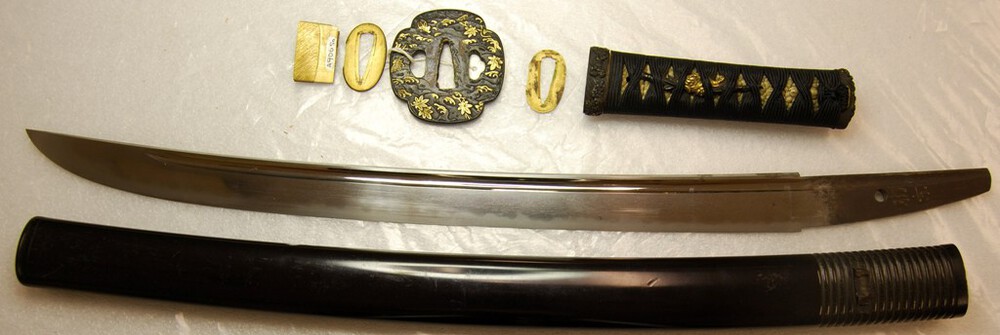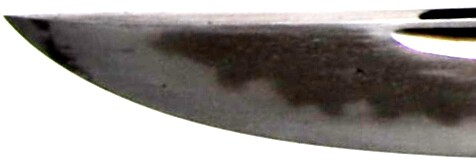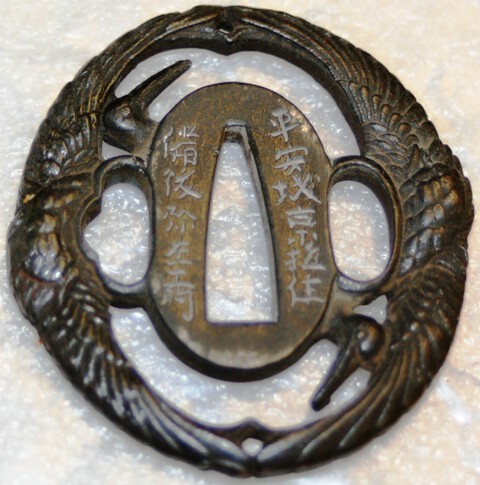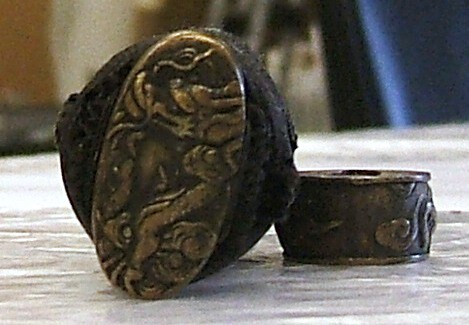
D-Lewis
Members-
Posts
14 -
Joined
-
Last visited
Everything posted by D-Lewis
-
Request with Hira-zukuri Ko-wakazashi please
D-Lewis replied to D-Lewis's topic in Translation Assistance
Wow. Talk about a diversity of answers. Ok...no laughing :-) Here's my try Blade type: Ko-dachi (1 shaku, 2 sun, 2.1 bu) Construction: Shinogi-zukuri, Koshi-zori Nakago Futsu with Kiri-Jiri and Sujikai Yasurime Mei appears on the outside with the blade down like a tachi. Looks shortened but I don't have enough smarts to get me to a Naginata. Let the learning begin :-) Regards Doug -
Request with Hira-zukuri Ko-wakazashi please
D-Lewis replied to D-Lewis's topic in Translation Assistance
Good evening, Jacques your comment is revealing to me. I have read the Connoisseur's...section on tanto/wakazashi (63-65) and didn't pick up that they only mention wakazashi until pg 64 Nanbokucho and then the length was only 30cm not 44cm. Sounds easy now but I had looked right passed it. Originally I thought it was omitted because of brevity. There isn't a mention of a Ko-Wakazashi of this length at all in the section. The closest is Late Edo out to 43cm. I also didn't make the clear distinction between Katana and Wakizashi with regards to the info in the book. Thanks for the help with understanding. Reinhard your terms are well chosen. If you notice I tend to have no shortage of words :-) I know it's old-hat for most of you on this forum but this kind of explanation helps me a great deal. I've also been going through the NCJSC Novice Course to learn more, it is far from Novice however, in my opinion (Thank you to Dr Robson). The issue with the sori seems to be 2 parts for me. The first I think is a bit of visual trickery. My mind imagines the curve one way. Second, I was looking only at the mune. When I also add in the ha towards the Kissaki I agree the curvature seems to move closer to the end. Yes, I am definately an amateur with taking photos of swords. I've looked around a little and haven't found a good reference for this. Do any of the Nihonto-Sensei here have something on techniques of properly photographing a Nihonto to bring out its beauty? The more I read, and admit my inaccuracies :-) I see similarities in Momoyama. Hira-zukuri, wide mihaba (about 3.5 cm at machi and 2.8cm at kissaki),proportional kissane (.7cm),stronger zori(not), fukura is rounded. Zori is off from Momoyama and the length is perplexing and seems to be more like late Edo. What a wonderful puzzle. The weight and feel of the blade is heavy, balanced and sharp as anything. You pick it up and just want to hear it sing. Thanks again Doug -
Request with Hira-zukuri Ko-wakazashi please
D-Lewis replied to D-Lewis's topic in Translation Assistance
Reinhard, Can you lead me through this? The few sources I have do not talk to this and I still don't have enough brain cells to make any leaps. This one still looks like Torii zori to me. I had to flip it because I can't do it in my head :-) If it was Torii wouldn't that speak more towards your first idea of Kamakura vice contrasting it with saki?Looking at the pictures I have, your description of the hamon is great. I went back and compared several examples and see exactly what you mean. I think learning this would be made more efficient under a Yoda-like tutor :-) I'm struggling with the mei primarily because it is my weakest area. Using your analysis and comparing it with the little I have, it does seem peculiar one of the strokes is missing. Is that common of a particular smith? Could it have been a student? or something I was thinking earlier, were mei ever stamped into the nakago? I thought maybe this would account for Jean's comment about how crisp they look. What is your primary reference for mei? Is it a particular book, site or the gift of reading it? Thank you for your insight Time to hit the books Regards Doug -
Request with Hira-zukuri Ko-wakazashi please
D-Lewis replied to D-Lewis's topic in Translation Assistance
Hello, Nagasa is 44.8cm or 1 Shaku, 4 Sun, 7.48 Bu I attached a picture of the blade and apologize if it is not at the proper angle. Thank you for your curiosity :-) Regards Doug -
Request with Hira-zukuri Ko-wakazashi please
D-Lewis replied to D-Lewis's topic in Translation Assistance
I am always humbled at just how little I know :-) Taking a look at your posts I see that I was a bit off originally (more like way off) The Mei is really something I need to study but I've put it below figuring out blades. I'm going back over the terms to make sure I fully understand the wisdom imparted. Jean, I looked at your link and it has a number of similarities. It has been polished and you can see the attributes really well. I've bookmarked the page and intend to search through it more thoroughly. Brian, the Hi is one continuous groove. It doesn't have a second line and originally I thought the hi went through the end of the handle but it actually tapers and ends just at the tip. I am also learning to properly photograph them :-) BTW, what is the term for a mune that starts ihori and then flattens out in the middle of the blade? Jean, as to the blade being modern do you mean recently? It was purchased back around 1880 and sat in a gallery for a while and then a storage drawer for almost 100 years. My books (all 5 of them so far) don't have a lot of mei in them. I've seen a few offered but as they are in Japanese I haven't the skill to utilize them yet. Do you have any suggestions for books possibly? The mekugi-ana does look clean compared to the few others I've seen. Could it have been heated and then stamped out? Have a lot of reading on my hands. Thank you all for your help Regards Doug -
Request with Hira-zukuri Ko-wakazashi please
D-Lewis replied to D-Lewis's topic in Translation Assistance
Hello John, Thank you for you help. Sorry for the delay in reply. I've been reading about Niji may and find Nijimei was most popular in Koto Era blades. They were specifically popular during the Heian (782-1184) and Kamakura (1184-1332) periods. Looking at the NihontoClub.com swordsmith database (an incredible resource!) I found 18 Sukemune with 3 being from Kamakura. I will be taking a closer look at these a see if they pan out. Thank you again for your help with my language skills. :-) Regards Doug -
Hello, hope everyone is having a great New Years eve :-) Working on a sword and am struggling. Any assistance would be greatly appreciated. This is what I have so far: Sugata=Hira zukuri Ko-wakazashi Torii zori of 1.1cm Hada = ko-mokume to masame Hamon = (where I'm having the most trouble) Gunome midare Nioi or Nie...no idea. haven't figured out what to look at or for Boshi = Kaeri fukai Kissaki = O-kissaki with rounded fukura Hi = tome is kakitoshi, hisaki is agaru Mune = is Ihori at machi but flattens to nothing halfway down the blade (no idea what that's called) Nakago = Ubu 11.6cm, futsu Nakagojiri = Kurijiri with Kattesagari yasurime Mei = Niji-mei (think the second character may be Mune) Have not had time to get to Koshirae yet. Maybe this weekend. :-) Have looked through a few Kanji charts but could only get a guess at the second character. Thank you for your help and tutelage. Regards Doug Also, not having a proper grasp of Japanese, if I have misused a term please let me know.
-
Hello, I'm new to the forum but saw this and thought I would throw in a comment and a picture. Snipe looks right but also maybe a Kiwi? Learning about tsuba a little every day, this looks like the same artisan, maybe mid 1500's like Muromachi or Momoyama? Kachushi or Myochin school? Thought I would also add a photo of a tsuba belonging to a sword I haven't had time to research yet. Beautiful! Regards Doug
-
Thank you Brian. I'm on the trail of Tsuba info to add detail about the sword. Looks like there is a unique culture just for that, similar to swords. It continues to amaze me how much detail is out there about swords. Regards Doug
-
Hello, I see everyone likes mor pixs...that I have...info I'm workin on :-) Thank you for the information about the Yoshimitsu family. That's another aspect I have added to my to-learn list. Would be nice if I could quit my job and just do this but ya can't eat on addiction. :-) Eating the elephant one bite at a time, I have a question. If the Tsuba has a pear on it, Fuchi and Kashira and Menuki all have dragons, wouldn't the Saya have a dragon on it, instead of an odd looking bird? See photo attached. Seems like there would be some effort put into cohesion right? Is there a book for Tsuba like Yumoto's book is to swords? Lot to digest, one step at a time :-) Thanks again. Regards Doug
-
Thank you for the suggestions and pictures. They are very helpful in teaching me the differences you all have referred to. I've looked at the Kantei as suggested and I believe it is the same name rendered in a different hand (I think). The Shu character-the primary vertical strokes have more of an angle to them and are shorter, I'm unsure of the exact direction of the strokes. The Osa character looks like someone drew the character in soft mud (with the sword I am looking at) with the way the sides of the character are raised, the bottom "hook" seems very close and in the same direction although the hook in the Kantei is not as round. The geometry of the box portion of the Yoshi character seems a little different in that the bottom horizontal stroke is not parallel with the top one, in the Kantei the two vertical strokes in the center appear to flow parallel versus in a northeastern direction. Does it matter if the Mei are on a different side of the tsuka? Did a swordsmith only sign on one particular side? The rendering at the following link: http://sinogi.dee.cc/osigata/katana/yo% ... u-k230.jpg that was graciously provided looks very close to an exact match. Stroke length on the Shu character are very close and appear to be in the same direction, there is a slight change in angle in the upper portion of the Osa character but looks like it was "carved" in the same direction, The Yoshi character is also very close, there is a slight increase in the length of the center strokes and a small change in the angle of the bottom left stroke but minor, the Mitsu seems to be the same to me. I tried to get an Oshigata of the Tsuka but that is yet another area I will improve on over time. It was difficult to get the characters to transfer. Not sure if the paper was too thick or the charcoal was too hard. The complexities of the subject are amazing and intriguing. Thank you all for your patience with me learning from you. Regards Doug
-
Hello, Thanks for the replies. Sadamitsu vice Yoshimitsu. I have both translations written in my notes and I have a few examples of different ways to write them. All of which makes it more perplexing for me as I try and teach myself how to read it. Nagayama's book (Connoisseur's....) talks about Yoshimitsu being one of the leading smiths in the Sue-Bizen school. Osafune Yoshimitsu is specifically called out during the Nanbokucho Period but not Muromachi I don't see any reference to either Sada or Yoshi later on but I haven't figured out all of the schools yet. Is there a good place to hunt for info on Sadamitsu or Yoshimitsu? Sadamitsu shows up in the Yamato tradition-Hosho School, so maybe he was making swords on into the middle of the Muromachi period? However the yasurime is sujikai... Appreciate the discussion Regards
-
Hello everyone, New guy here :-) Have been reading on the board and wanted to ask for some help. Per the posting suggestions, some background...based on my martial arts experience and being a research nerd :-) my friend asked if I would help her do some unofficial (not commercial) research on a few Japanese Swords in her museum (name not included per her request). Until I stumbled along they hadn't had anyone who knew more than just to point and say sword. I'm only a little better :-) I have read a few books now on the subject and have consulted a ton of kanji charts...I have had some success with the first sword in that I was able to date the sword to Bun-Mei San-Nen Hachi-Gatsu Hi (or Aug 1471...I think)...that took a month. The other side of the nakago has mostly eluded me however. Of the 6 characters, I think the first two are either Bizen or Bishu, third possibly Naga or Osa, Fourth no clue unless it is Fune (think OSAFUNE is wishfull thinking), Fifth possibly Sada, Sixth possibly Mitsu. I have read a little on Bizen/Bishu and the 8 Roads, and believe the Sanyoudou road matches. If characters 3 & 4 are Osafune that provides a possibility of shortening the list of smiths. The last two characters if my wild guesses are close is Sadamitsu which doesn't show up in either Bizen or Bichu smiths Thus I am left with asking help in hopes of getting somewhere on figuring out who the smith was on this sword. If you have the bandwidth and can offer any assistance I would greatly appreciate it. Admittedly I have a number of other swords I am researching but as to not abuse the site I am hoping to learn enough to complete the rest of the swords via my own noggin :-) Thank you for your consideration Regards Doug














